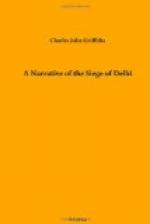Some two stages from Delhi, after changing horses and proceeding on the journey along the pucka road, I fell into a doze, and at last into a sound sleep. From this I was rudely awakened by shouts of “Chor! chor!” (Thief! thief!) from my bearer and the native coachman. Starting up, I seized the pistols, and opening the doors of the ghari, saw, as I fancied, some forms disappearing in the darkness at the side of the road. I fired two barrels in the direction and pursued for some distance, but finding that my shots had not taken effect, and fearful of losing my way—for the night was pitch-dark—I returned to the carriage. My bearer then told me that some robbers had climbed up the back of the ghari, taken the two petarahs between which he was lying, and made off into the country. We had been driving at the usual pace, about six miles an hour, and it proves the practised skill and agility of the goojars, who, with such ease, had abstracted the boxes from under the very nose of my servant. There was nothing for it but to continue my journey regretting the loss of my personal effects, but still fortunate in one respect—that the loot was safe under my pillow.
November 9.—At the next stage I questioned the horse-keeper, acquainting him with the robbery, and learned that a village inhabited by goojars lay off the road not far from the place where the robbery had been perpetrated. In the morning I arrived at the civil station of Karnal, and drove to the residence of the Commissioner, to whom I reported my loss, giving the name of the village where it had occurred. He told me to make out a valuation of the things stolen and to send it to him on the first opportunity. This I did on reaching Umballah, fixing the value of the different articles in the boxes at 250 rupees. A month afterwards, when the affair had almost faded from my memory, I received a letter from the Commissioner stating that he had visited the village near the spot where the robbery had taken place. The headman had been summoned to his presence, and warned that, unless the thieves were given up and the boxes returned with their contents intact, he would confiscate a certain number of cattle, and sell the same to indemnify me for the losses I had sustained. These orders being unfulfilled, the cattle were sold, and an order for 250 rupees was enclosed to me in the letter. The boxes, quite empty, with the exception of my journals, were found afterwards at the bottom of a well and were forwarded to Umballah. The ink had run in the journals from immersion in the water, but the writing was little defaced, and these papers—to me the most precious part of my luggage—I was glad to recover.
The change to Umballah was at first beneficial, but later on I suffered a relapse; and after appearing before a medical board, was granted a year’s leave to England.
From Umballah I journeyed to Ferozepore, where I met several of my brother-officers and others who, like myself, had been invalided home.




